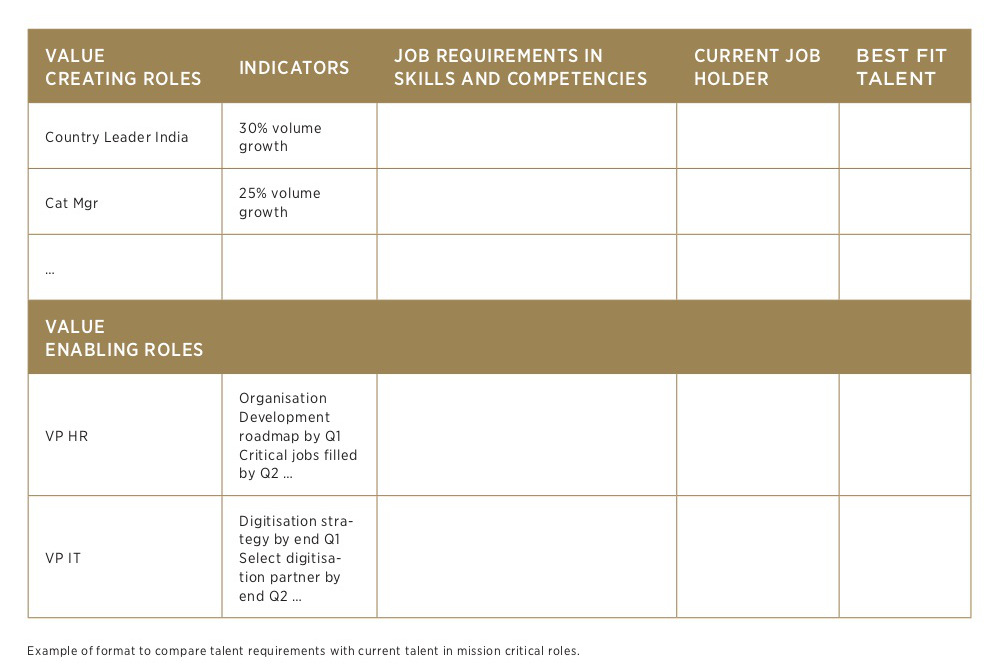The success of your strategy and its execution is directly linked to the quality of your people. Now, there is and will always be a shortage of “great people”. Therefore, to solve your talent ‘supply and demand’ dilemma and increase the likelihood of winning, focus by priority on filling those roles and teams that will create the most value with the best people.
By Guy De Herde
Have you ever experienced the following: you have a great idea for a new product or business line, and you give it to a person you know or who is available, only to find out your idea does not get traction or does or does not deliver what you expected?
Making a strategy is the easy part
We have worked with a fast-growing and (on all financial and other measures) highly successful bio-tech company. The business wants to accelerate its growth and double the sales in the next 7 years. Creating a strategy to achieve this ambition was the easy part. It could only be achieved however if the business attracted and/or developed leaders with the capability of building and leading a business of twice its current size and if they hired enough people with the right skills to fill its vacancies around the world. It’s very likely that many of our client’s competitors have similar strategies.
Implementation is a ‘People Business’
Hence, our client would only win by the quality and speed of implementation, and the speed of adaptation when a changing environment requires this. Implementation and adaptation are now a ‘people business’: having enough people, of the right quality, at the right time and the right place, being well-aligned, and working well together. It sounds so easy when you say it. Trouble is, that’s exactly what the competition is trying to achieve as well, so our client is fighting the ‘talent war’. Aren’t you as well?
Let’s face it, especially in rapidly growing businesses (as well as those wanting to transform) there will always be a gap between the demand for talent and the supply of talent.
Focus on linking talent to value
What’s the solution? Not only it is practically impossible to fill all your roles with the best talent, it is also very expensive and — in reality — not always required.
In our experience (as business leaders, advisors, and owners of our own scale up), it is critical to deploy your best talent in those jobs that matter most to the execution of your strategy. Call them your “mission critical jobs”1. In reality, 20% of your jobs/roles drives 80% of the results. In scale up situations, it can well be that 10% of your roles drives 90% of your (expected) results.
How does linking talent to value work?
1
It’s quite an innovative and provoking process asking a leadership team to list the most important individual roles in the organisation, through the lens of strategy execution. At many of our clients, the management team asks HR to deliver the list of High Potentials and Fast Trackers. But that is NOT what we look for in this approach: we want to identify those roles that are mission critical for the strategy implementation, i.e. those that create or enable the creation of value as intended (and required) by the strategy.
This dialogue generates great insights. One client’s executive team realised that the successful implementation of their strategy really depended on 15-20 individual roles (not job families), located sometimes several levels below them across their organisation. For instance, the product leader of a category that would drive >10% of overall growth, the country leader of India (even if the business turnover now was less than 2% of total turnover), a marketing manager at the HQ, a Key Account Manager in the US, the VP HR (not in the Management Team?!) and the VP IT (same!)
We asked the same about the teams: on which 5 teams does your strategy depend? Which 5 teams should create or enable the value in your strategy?
2
For each mission critical role, we ask to detail the value to be created to fulfil the strategic ambition of the business.
3
Once the roles had been identified, define the key skills and competencies that the job holder required to be successful in his/her mission. This step is important for objective assessments and discussions on talent, rather than a gut-feeling or personal preference.
4
The step is always confrontational and sobering. Ask yourself the questions: do you have your best people in these mission critical roles? Do the people in these critical roles at present have the required skills and competencies? The required performance track-record?
Leadership teams often came to realise that in several instances, people with the wrong profile occupied mission critical roles and/or they were missing the in-house talent. An “aha” moment, and reflecting on “why” targets have often not been met as planned.
The work does not stop with this list of mission critical roles and teams. The final step is to act on the insights and deploy your best talent in those jobs that will “make the difference”. Ensuring that critical teams are high- performing teams, with all the resources and support to win!

The top team ‘owns’ this list
As a CEO and Executive Team, you obviously need to take care of all your people, but the people and teams on these 2 lists need to be top of mind for you — you need to look out for them, coach them, develop them, hold them accountable, motivate them, and recognise them. You should discuss their progress and delivery at each meeting. The successful execution of your business strategy depends on it.